The Inflation Reduction Act (IRA) was signed into law on August 16, 2022, providing an unprecedented $369 billion of federal funding for energy and climate provisions. While the IRA itself is over 700 pages and represents a significant time commitment to read, I have compiled information on the energy efficiency and climate change aspects of the bill that can be digested quickly as it relates to buildings. Here’s what the Architecture, Engineering, and Construction (AEC) industry needs to know about the IRA.
How is the IRA different from previous legislation?
The Inflation Reduction Act marks the largest climate investment in U.S. history, bringing us much closer to the goal of cutting net greenhouse gas emissions in half by 2030. A preliminary assessment by the Rhodium Group, an independent research provider, estimated the IRA would reduce national greenhouse gas emissions 31–44% below 2005 levels by 2030, compared to 24–35% under current policy.
What’s unique about the IRA?
This legislation fundamentally revises the tax code to incentivize the deployment of low carbon technologies. Under the IRA, tax codes are used to advance clean energy technologies and fight climate change. The IRA allows taxpayers, in some situations, to elect a direct pay option instead of a tax credit, or the option to monetize the credits by transferring them to another entity.
So even if you represent a non-profit or a public entity, you can directly benefit from the incentives without having to go to a third party such as a power purchase financier for solar developments, who may or may not pass on the entire solar tax incentives directly to the owner. This applies to alternative fuel vehicle fueling, renewable electricity production, carbon sequestration, clean hydrogen, zero-emission nuclear power, and more.
The IRA restores, modifies, and expands several tax credits and other incentives, while simultaneously creating new credits. Many of these provisions provide two credit values: a lower base credit and a bonus rate. These bonus rates are unique and can add up quickly. While I am not a tax expert, I encourage all to speak to a qualified tax professional to learn more.
For example, with the Investment Tax Credit, for solar systems installed from 2019-2022, a 26% tax credit applied for tax paying entities, and it was to go down to 22% starting 2023 and 10% starting 2026. Now for projects starting construction before the end of 2024, the 30% credit applies if prevailing wage and apprenticeship requirements are met for all public or private entities in 2023. In addition, one can claim additional 10% increments of savings if one of the following applies: if a certain percentage of domestic content is provided; if the project is in an energy community; or if the project is located in a low-income community. Projects are eligible for up to 20% if they are a qualified low-income housing project or low-income economic benefit project. Battery storage and geothermal also apply in addition to solar and wind systems.
Why should I care?
Due to these new provisions, investments in energy efficiency, carbon reduction, and renewable energy that were previously not cost effective are now potentially viable, with a 30 to 60% discount on certain alternative energy systems and a 140% to 280% increase in incentives towards existing building upgrades.
This has far-reaching ramifications for lowering consumer energy costs, supporting energy security and investment in clean energy manufacturing, decarbonizing the economy, investing in communities and environmental justice, and advancing resilience efforts. This not only effects our industry, but the lived experience of communities nationwide. It is vital that we as AEC professionals understand the potential impacts and harness them to better human life, now and for future generations.
What markets are affected?
The IRA will have far-reaching impacts on all markets. For the purposes of this blog, I will focus on the architecture and building engineering market. In addition to the renewable energy incentives described above, the following incentives apply to commercial and manufacturing buildings:
Energy Efficient Buildings
- Extends and expands the Energy Efficient Commercial Buildings Deduction – Section 179D to increase the baseline to the American Society of Heating, Refrigerating and Air-Conditioning Engineers (ASHRAE)1-2007 and reduce the savings required from 50% to 25% from $2.50 to $5.00 per square foot from $1.80 per square foot previously.
- $1 billion to support state and local governments to adopt updated building codes such as 2021 International Energy Conservation Code (IECC) or the equivalent ASHRAE 90.1-2019, with additional funding if the net zero provisions within IECC or equivalent stretch codes are adopted, including training and enforcement of the code.
Carbon Dioxide Removal and Hydrogen Technology
- The bill includes gems for carbon sequestration and removal technology and renewably powered hydrogen facilities.
- Increases the current tax credit for direct air capture (DAC) — capturing carbon directly from the atmosphere significantly, representing a 30 to 50% subsidy for these projects.
Low-Carbon Transportation Materials Grants
- Provides $2 billion to FHWA to reimburse or provide incentives to state, local governments and metropolitan planning organizations for the use of low-embodied carbon construction materials and products in projects, and for the operations and administration FHWA.
- Reimbursement amounts equal to incrementally higher cost of using materials relative to the cost of using traditional materials; Incentive amount equal to 2 percent of the cost of using low-embodied carbon construction materials and products
Public Agency Funding
- Facilities of the National Oceanic and Atmospheric Administration (NOAA) and National Marine Sanctuaries. Provides $200 million for the construction of new NOAA facilities, including piers, marine operations facilities and fisheries laboratories; it provides $50 million to construct facilities to support the National Marine Sanctuary System.
- Provides $2 billion for National Labs to accelerate breakthrough energy research Authorizes Federal Emergency Management Agency (FEMA) to allocate funds for purchasing low-carbon building materials and incentives for low-carbon and net-zero energy projects via disaster recovery programs.
- Provides $250 million to the Federal Buildings Fund to convert General Services Administration (GSA) facilities to high-performance green buildings
- Provides $975 million to the Federal Buildings Fund for emerging and sustainable technologies and related sustainability and environmental programs
- Provides $2.15 billion to the Federal Buildings Fund to acquire and install low-embodied carbon materials and products for the construction and alteration of buildings under jurisdiction, custody, and control of the GSA.
The Inflation Reduction Act significantly improves the return on investment for energy efficiency, carbon and renewable energy investments. Reach out to Mead & Hunt for details on how the IRA can be taken advantage of to reach your organization’s energy or carbon goals.
If you want to read further, check out these writeups:
- How the New Climate Bill Would Reduce Emissions
- The Inflation Reduction Act: Summary of Budget Reconciliation Legislation
- Summary of the Energy Security and Climate Change Investments in the Inflation Reduction Act of 2022
- How the New Climate Bill Promises to Cut Inflation, Upgrade the Economy, and Slash Emissions
Disclaimer: This article should not be used to make investment decisions without consulting your financial tax advisors.



